Abstract
Monocytes are heterogeneous both in terms of physical properties and in their functional capacity. Isolation of monocytes from peripheral blood may perturb the observed heterogeneity for purified cell preparations. To explore this possibility we examined monocytes prepared by two techniques, counter-flow centrifugation elutriation (CCE) and fibronectin adherence, in terms of cell-surface molecule expression and several physical properties. Although such cells would be expected to represent dissimilar cross-sections of the total monocyte population, they were found to have similar cell-surface antigenic profiles. Observed differences in levels of expression of several molecules (CR1, CR3 and the antigen recognized by LP9 antibody) were found to be a temperature-related phenomenon. These results indicate that monocytes are not divisible into 'subpopulations' on the basis of cell-surface molecule expression and suggest that heterogeneity of monocytes may reflect the presence in the circulation of a continuum of maturational/activation states.
Full text
PDF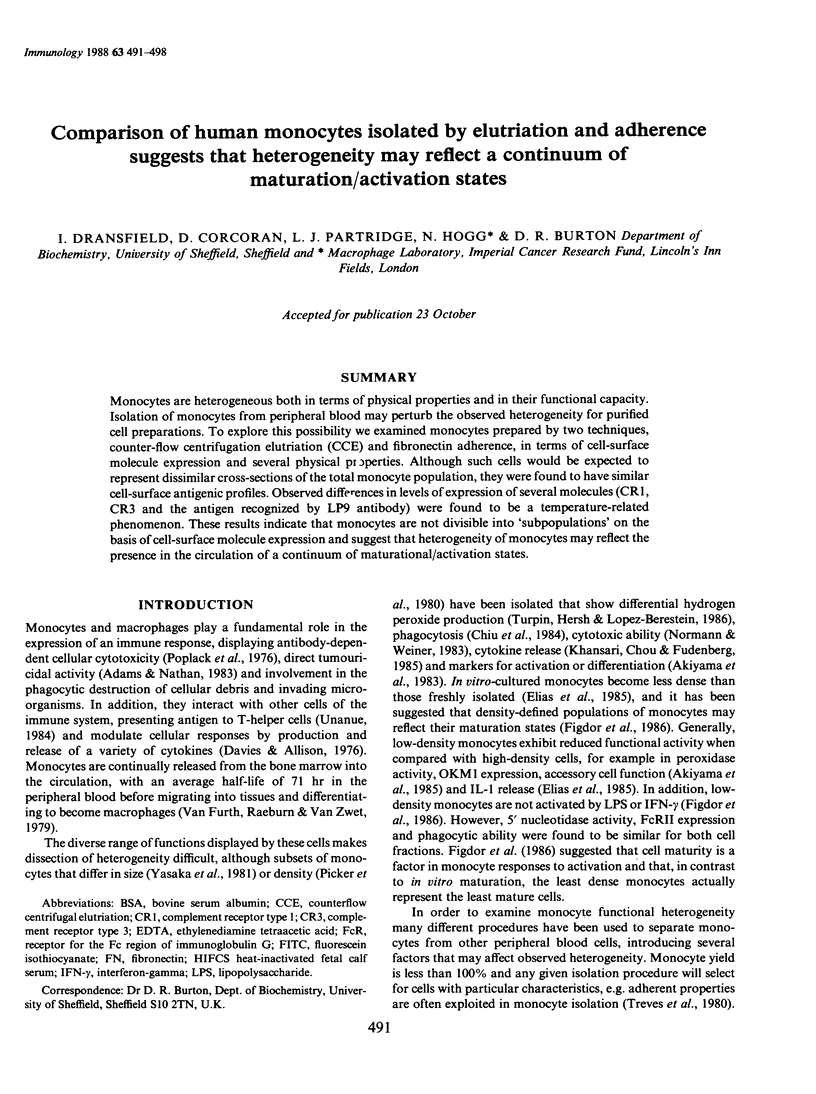
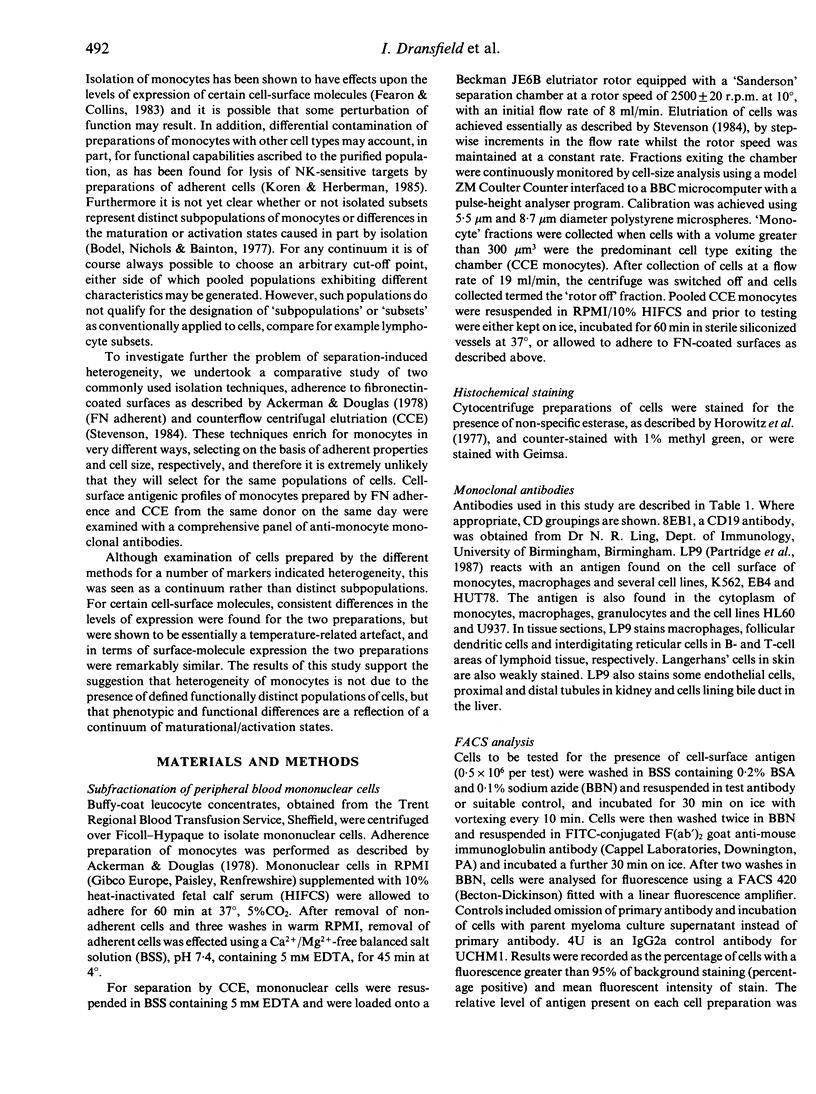

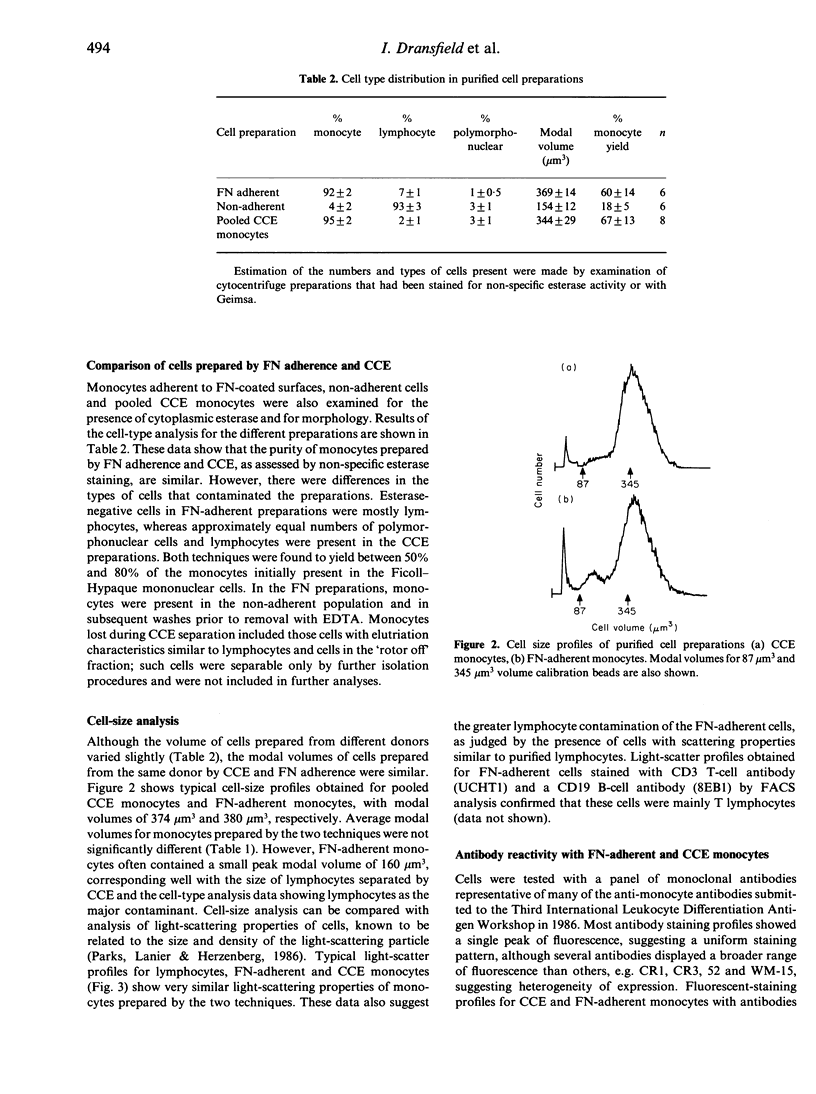


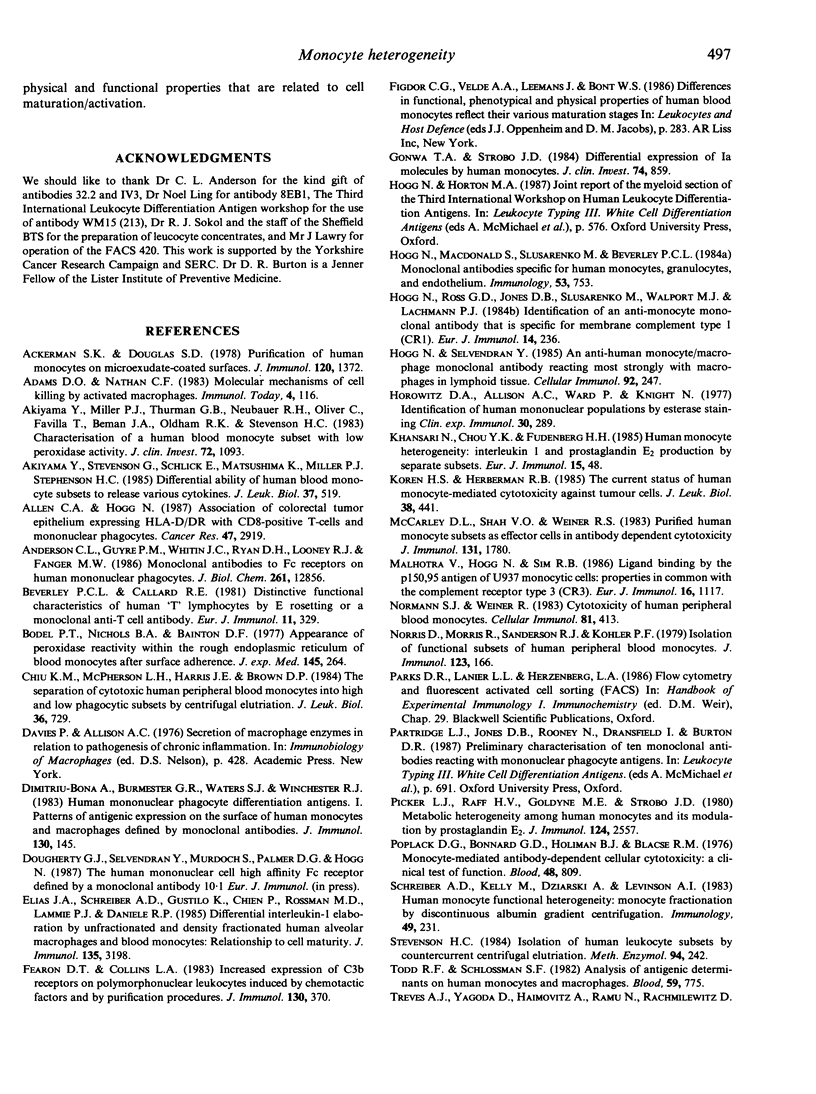
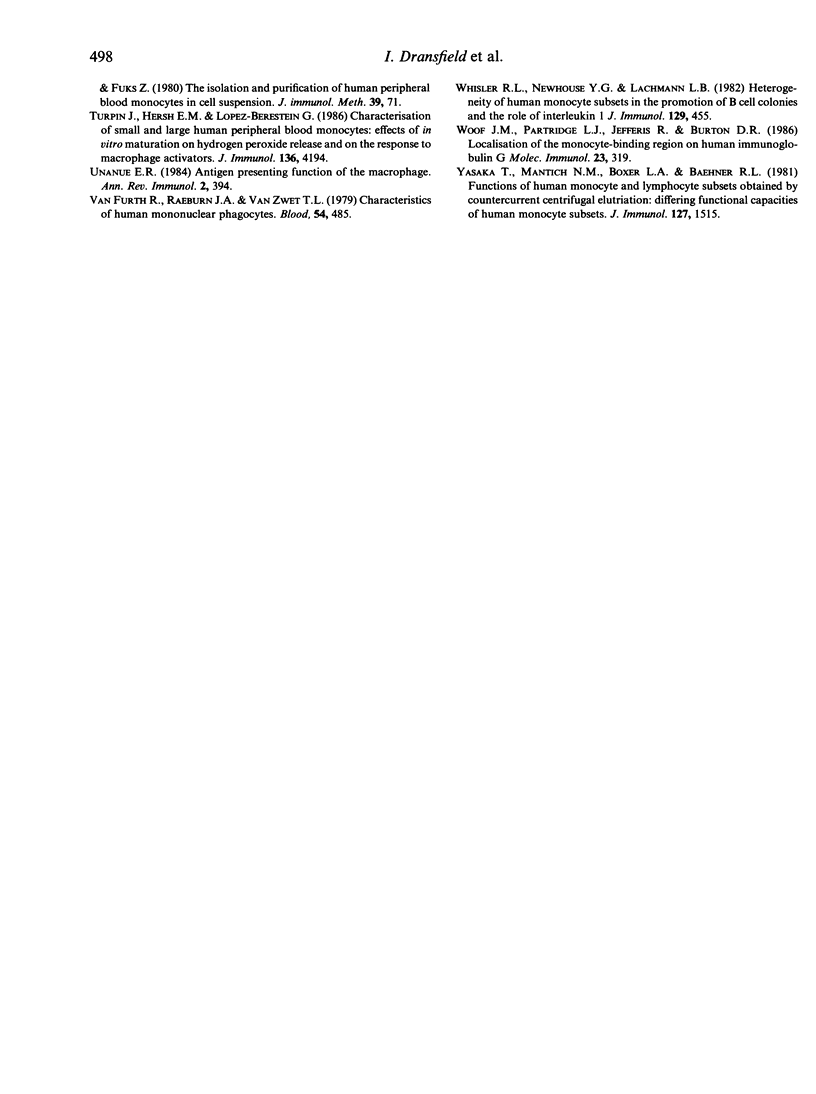
Selected References
These references are in PubMed. This may not be the complete list of references from this article.
- Ackerman S. K., Douglas S. D. Purification of human monocytes on microexudate-coated surfaces. J Immunol. 1978 Apr;120(4):1372–1374. [PubMed] [Google Scholar]
- Akiyama Y., Miller P. J., Thurman G. B., Neubauer R. H., Oliver C., Favilla T., Beman J. A., Oldham R. K., Stevenson H. C. Characterization of a human blood monocyte subset with low peroxidase activity. J Clin Invest. 1983 Sep;72(3):1093–1105. doi: 10.1172/JCI111034. [DOI] [PMC free article] [PubMed] [Google Scholar]
- Akiyama Y., Stevenson G. W., Schlick E., Matsushima K., Miller P. J., Stevenson H. C. Differential ability of human blood monocyte subsets to release various cytokines. J Leukoc Biol. 1985 May;37(5):519–530. doi: 10.1002/jlb.37.5.519. [DOI] [PubMed] [Google Scholar]
- Allen C. A., Hogg N. Association of colorectal tumor epithelium expressing HLA-D/DR with CD8-positive T-cells and mononuclear phagocytes. Cancer Res. 1987 Jun 1;47(11):2919–2923. [PubMed] [Google Scholar]
- Anderson C. L., Guyre P. M., Whitin J. C., Ryan D. H., Looney R. J., Fanger M. W. Monoclonal antibodies to Fc receptors for IgG on human mononuclear phagocytes. Antibody characterization and induction of superoxide production in a monocyte cell line. J Biol Chem. 1986 Sep 25;261(27):12856–12864. [PubMed] [Google Scholar]
- Beverley P. C., Callard R. E. Distinctive functional characteristics of human "T" lymphocytes defined by E rosetting or a monoclonal anti-T cell antibody. Eur J Immunol. 1981 Apr;11(4):329–334. doi: 10.1002/eji.1830110412. [DOI] [PubMed] [Google Scholar]
- Bodel P. T., Nichols B. A., Bainton D. F. Appearance of peroxidase reactivity within the rough endoplasmic reticulum of blood monocytes after surface adherence. J Exp Med. 1977 Feb 1;145(2):264–274. doi: 10.1084/jem.145.2.264. [DOI] [PMC free article] [PubMed] [Google Scholar]
- Chiu K. M., McPherson L. H., Harris J. E., Braun D. P. The separation of cytotoxic human peripheral blood monocytes into high and low phagocytic subsets by centrifugal elutriation. J Leukoc Biol. 1984 Dec;36(6):729–737. doi: 10.1002/jlb.36.6.729. [DOI] [PubMed] [Google Scholar]
- Dimitriu-Bona A., Burmester G. R., Waters S. J., Winchester R. J. Human mononuclear phagocyte differentiation antigens. I. Patterns of antigenic expression on the surface of human monocytes and macrophages defined by monoclonal antibodies. J Immunol. 1983 Jan;130(1):145–152. [PubMed] [Google Scholar]
- Elias J. A., Schreiber A. D., Gustilo K., Chien P., Rossman M. D., Lammie P. J., Daniele R. P. Differential interleukin 1 elaboration by unfractionated and density fractionated human alveolar macrophages and blood monocytes: relationship to cell maturity. J Immunol. 1985 Nov;135(5):3198–3204. [PubMed] [Google Scholar]
- Fearon D. T., Collins L. A. Increased expression of C3b receptors on polymorphonuclear leukocytes induced by chemotactic factors and by purification procedures. J Immunol. 1983 Jan;130(1):370–375. [PubMed] [Google Scholar]
- Gonwa T. A., Stobo J. D. Differential expression of Ia molecules by human monocytes. J Clin Invest. 1984 Sep;74(3):859–866. doi: 10.1172/JCI111503. [DOI] [PMC free article] [PubMed] [Google Scholar]
- Hogg N., MacDonald S., Slusarenko M., Beverley P. C. Monoclonal antibodies specific for human monocytes, granulocytes and endothelium. Immunology. 1984 Dec;53(4):753–767. [PMC free article] [PubMed] [Google Scholar]
- Hogg N., Ross G. D., Jones D. B., Slusarenko M., Walport M. J., Lachmann P. J. Identification of an anti-monocyte monoclonal antibody that is specific for membrane complement receptor type one (CR1). Eur J Immunol. 1984 Mar;14(3):236–243. doi: 10.1002/eji.1830140307. [DOI] [PubMed] [Google Scholar]
- Hogg N., Selvendran Y. An anti-human monocyte/macrophage monoclonal antibody, reacting most strongly with macrophages in lymphoid tissue. Cell Immunol. 1985 May;92(2):247–253. doi: 10.1016/0008-8749(85)90006-1. [DOI] [PubMed] [Google Scholar]
- Horwitz D. A., Allison A. C., Ward P., Kight N. Identification of human mononuclear leucocyte populations by esterase staining. Clin Exp Immunol. 1977 Nov;30(2):289–298. [PMC free article] [PubMed] [Google Scholar]
- Khansari N., Chou Y. K., Fudenberg H. H. Human monocyte heterogeneity: interleukin 1 and prostaglandin E2 production by separate subsets. Eur J Immunol. 1985 Jan;15(1):48–51. doi: 10.1002/eji.1830150110. [DOI] [PubMed] [Google Scholar]
- Koren H. S., Herberman R. B. The current status of human monocyte-mediated cytotoxicity against tumor cells. J Leukoc Biol. 1985 Sep;38(3):441–445. doi: 10.1002/jlb.38.3.441. [DOI] [PubMed] [Google Scholar]
- Malhotra V., Hogg N., Sim R. B. Ligand binding by the p150,95 antigen of U937 monocytic cells: properties in common with complement receptor type 3 (CR3). Eur J Immunol. 1986 Sep;16(9):1117–1123. doi: 10.1002/eji.1830160915. [DOI] [PubMed] [Google Scholar]
- McCarley D. L., Shah V. O., Weiner R. S. Purified human monocyte subsets as effector cells in antibody-dependent cellular cytotoxicity (ADCC). J Immunol. 1983 Oct;131(4):1780–1783. [PubMed] [Google Scholar]
- Normann S. J., Weiner R. Cytotoxicity of human peripheral blood monocytes. Cell Immunol. 1983 Oct 15;81(2):413–425. doi: 10.1016/0008-8749(83)90248-4. [DOI] [PubMed] [Google Scholar]
- Norris D. A., Morris R. M., Sanderson R. J., Kohler P. F. Isolation of functional subsets of human peripheral blood monocytes. J Immunol. 1979 Jul;123(1):166–172. [PubMed] [Google Scholar]
- Picker L. J., Raff H. V., Goldyne M. E., Stobo J. D. Metabolic heterogeneity among human monocytes and its modulation by PGE2. J Immunol. 1980 Jun;124(6):2557–2562. [PubMed] [Google Scholar]
- Poplack D. G., Bonnard G. D., Holiman B. J., Blaese R. M. Monocyte-mediated antibody-dependent cellular cytotoxicity: a clinical test of monocyte function. Blood. 1976 Dec;48(6):809–816. [PubMed] [Google Scholar]
- Schreiber A. D., Kelley M., Dziarski A., Levinson A. I. Human monocyte functional heterogeneity: monocyte fractionation by discontinuous albumin gradient centrifugation. Immunology. 1983 Jun;49(2):231–238. [PMC free article] [PubMed] [Google Scholar]
- Stevenson H. C. Isolation of human mononuclear leukocyte subsets by countercurrent centrifugal elutriation. Methods Enzymol. 1984;108:242–249. doi: 10.1016/s0076-6879(84)08087-3. [DOI] [PubMed] [Google Scholar]
- Todd R. F., 3rd, Schlossman S. F. Analysis of antigenic determinants on human monocytes and macrophages. Blood. 1982 Apr;59(4):775–786. [PubMed] [Google Scholar]
- Turpin J., Hersh E. M., Lopez-Berestein G. Characterization of small and large human peripheral blood monocytes: effects of in vitro maturation on hydrogen peroxide release and on the response to macrophage activators. J Immunol. 1986 Jun 1;136(11):4194–4198. [PubMed] [Google Scholar]
- Whisler R. L., Newhouse Y. G., Lachman L. B. Heterogeneity of human monocyte subsets in the promotion of B cell colonies and the role of interleukin 1. J Immunol. 1982 Aug;129(2):455–460. [PubMed] [Google Scholar]
- Woof J. M., Partridge L. J., Jefferis R., Burton D. R. Localisation of the monocyte-binding region on human immunoglobulin G. Mol Immunol. 1986 Mar;23(3):319–330. doi: 10.1016/0161-5890(86)90059-3. [DOI] [PubMed] [Google Scholar]
- Yasaka T., Mantich N. M., Boxer L. A., Baehner R. L. Functions of human monocyte and lymphocyte subsets obtained by countercurrent centrifugal elutriation: differing functional capacities of human monocyte subsets. J Immunol. 1981 Oct;127(4):1515–1518. [PubMed] [Google Scholar]
- van Furth R., Raeburn J. A., van Zwet T. L. Characteristics of human mononuclear phagocytes. Blood. 1979 Aug;54(2):485–500. [PubMed] [Google Scholar]


